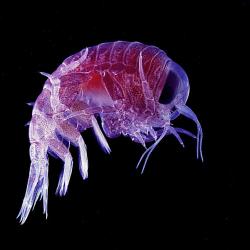Source Institutions
Source Institutions
Add to list Go to activity
Activity link broken? See if it's at the internet archive

In this two-part activity, learners investigate buoyancy, density and surface area as well as biodiversity and the relationship between the structure and function of organisms. In part one, learners use their creativity and imagination to design their own phytoplankton. In part two, learners "race" by placing their plankton in two matching water containers to see which sinks the slowest. If the plankton floats, it will be eaten by birds or surface feeders and is eliminated from the competition. Learners are engaged creatively in designing their own plankton and engaged competitively in “racing” their plankton. There are many variations of this activity that could include design challenges (using the same exact materials), art projects (learners vote on the best looking or most original plankton), or graphing the sinking rates.
- 5 to 10 minutes
- 1 to 2 hours
- Over $20 per group of students
- Ages 8 - 18
- Activity, Lesson/Lesson Plan
- English
Quick Guide
Materials List (per group of students)
- Various sizes of washers (representing heavy parts of the cell)
- Cloth
- Pipe cleaners
- Styrofoam shapes
- Beads
- Felt
- Straws
- Toothpicks
- Screens or meshes of various sizes
- Tape
- Large container of water (5 gallon bottled water with tapered top cut off works well)
- Any other materials can be used
Subjects
-
Earth and Space Science
-
Earth Structure
- Oceans and Water
-
Earth Structure
-
Life Sciences
-
Cells
- Cell Structure and Function
-
Diversity of Life
- Plants
- Animals
-
Ecology
- Biodiversity
-
Evolution
- Evidence for Evolution
- Mechanisms of Evolution
-
Cells
-
Physical Sciences
-
Structure and Properties of Matter
- Volume and Density
-
Structure and Properties of Matter
-
The Nature of Science
-
The Scientific Process
- Conducting Investigations
-
The Scientific Process
-
The Nature of Technology
-
The Design Process
- Invention and Innovation
-
The Design Process
Informal Categories
- Animals
- Arts and Crafts
- Nature and Environment
Audience
To use this activity, learners need to:
- see
- touch
Learning styles supported:
- Involves hands-on or lab activities
Other
Includes alignment to state and/or national standards:
Includes assesments for student learning:
This resource is part of:
Access Rights:
- Free access
By:
- Chen, Bob
Rights:
- All rights reserved, Centers for Ocean Sciences Education Excellence, 2012
Funding Sources:
- National Science Foundation, 0827983
- National Science Foundation, 0828142
- National Science Foundation, 0827953
- NOAA National Sea Grant
- Office of Naval Research
- National Oceanic and Atmospheric Administration
